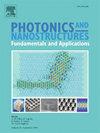Investigation of nonlinear optical properties in GaAs/GaAlAs quantum well with modified Lennard-Jones potential: Role of static electromagnetic fields, intense laser radiation and structure parameters
IF 2.9
3区 物理与天体物理
Q3 MATERIALS SCIENCE, MULTIDISCIPLINARY
Photonics and Nanostructures-Fundamentals and Applications
Pub Date : 2025-05-30
DOI:10.1016/j.photonics.2025.101403
引用次数: 0
Abstract
Through this theoretical investigation, we examine the role of various factors (electric field, magnetic field and intense laser field) on GaAs/GaAlAs quantum well with modified Lennard-Jones potential and their influence on the nonlinear optical rectification, second harmonic generation, and third harmonic generation. First, we calculate the wave functions and energy levels for the four lowest confined states in the structure by solving the Schrödinger equation via the diagonalization method in the framework of the effective mass and parabolic band approximations. The optical calculations utilize the density matrix formalism and the iterative method to express the different degrees of dielectric susceptibility. The intense laser effects on the system are calculated via the Floquet method, which modifies the confinement potential due to the heterostructure. The major outcomes of this quantitative research demonstrate a strong dependence between the mentioned parameters and optical properties. Magnetic field, electric field, intense laser field and potential change drastically the energy levels and matrix elements and thus modifies the optical characteristics. By appropriately manipulating the variables we can not only regulate the optical properties of the quantum well but also help developers in the creation of novel optoelectronic devices.
具有修正Lennard-Jones势的GaAs/GaAlAs量子阱非线性光学性质的研究:静态电磁场、强激光辐射和结构参数的作用
通过理论研究,研究了电场、磁场和强激光场等因素对具有修正Lennard-Jones势的GaAs/GaAlAs量子阱的作用,以及它们对非线性光学整流、二次谐波和三次谐波产生的影响。首先,我们在有效质量近似和抛物线带近似的框架下,通过对角化方法求解Schrödinger方程,计算了结构中四个最低约束态的波函数和能级。光学计算采用密度矩阵形式和迭代法来表示不同程度的介电磁化率。用Floquet方法计算了激光对系统的强作用,该方法修正了由于异质结构引起的约束势。该定量研究的主要结果表明,上述参数与光学性质之间存在很强的依赖性。磁场、电场、强激光场和电势剧烈地改变了能级和矩阵元素,从而改变了光学特性。通过适当地操纵这些变量,我们不仅可以很好地调节量子的光学特性,还可以帮助开发人员创造新的光电器件。
本文章由计算机程序翻译,如有差异,请以英文原文为准。
求助全文
约1分钟内获得全文
求助全文
来源期刊
CiteScore
5.00
自引率
3.70%
发文量
77
审稿时长
62 days
期刊介绍:
This journal establishes a dedicated channel for physicists, material scientists, chemists, engineers and computer scientists who are interested in photonics and nanostructures, and especially in research related to photonic crystals, photonic band gaps and metamaterials. The Journal sheds light on the latest developments in this growing field of science that will see the emergence of faster telecommunications and ultimately computers that use light instead of electrons to connect components.

 求助内容:
求助内容: 应助结果提醒方式:
应助结果提醒方式:


